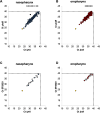Streptococcus pneumoniae carriage in adults during the COVID-19 pandemic in Portugal: dominance of serotypes included in broader PCVs and of serotype 3
- PMID: 40492709
- PMCID: PMC12306169
- DOI: 10.1128/msphere.00082-25
Streptococcus pneumoniae carriage in adults during the COVID-19 pandemic in Portugal: dominance of serotypes included in broader PCVs and of serotype 3
Abstract
Streptococcus pneumoniae (pneumococcus) is a leading cause of infections, particularly in infants and the elderly. Recent advances in molecular methods suggest higher pneumococcal carriage rates among adults than previously estimated, raising questions about their role in transmission. This study aimed to estimate pneumococcal carriage prevalence, identify circulating serotypes, and assess risk factors for colonization among adults during the COVID-19 pandemic in Portugal. We conducted a prospective observational study among civil servants aged ≥18 years in Oeiras Municipality from February 2021 to February 2022. Paired nasopharyngeal and oropharyngeal samples were analyzed using qPCR to detect pneumococcal carriage and 66 serotypes/serogroups. This included novel primers and probes for serotypes 4 and 24B/F, overcoming previous concerns associated with false positivity. Risk factors were identified using Bayesian adaptive sampling for variable selection in generalized linear model. Among 3,574 participants, 6.9% were pneumococcal carriers through qPCR without prior culture enrichment. Carriage rates were higher in oropharyngeal than nasopharyngeal samples (5.3% vs 3.7%, P < 0.001). Twenty-six serotypes/serogroups were identified, with the most common being non-encapsulated (NT), 10A, 23B, 3, 11A/D, 33A/F/37, 16F, and 31. Excluding NT, the most frequent serotypes collectively accounted for 45.3% of all carriers. Vaccine coverage estimates were 13.5% for PCV13, 20.4% for PCV15, 40.0% for PCV20, and 64.1% for PCV21. Contact with children < 18 years increased the odds of colonization by 2.73-fold (95% confidence interval [CI], 2.01-3.75), while being male reduced the odds by 54% (odds ratio = 0.46; 95% CI, 0.30-0.69). These findings emphasize the need for ongoing surveillance to clarify adults' role in pneumococcal transmission and support prevention strategies, including adult vaccination and community-level interventions, to mitigate pneumococcal disease.IMPORTANCEStreptococcus pneumoniae is a major pathogen causing significant disease worldwide, yet adult carriage remains underexplored. By evaluating pneumococcal carriage among adults in Portugal during the COVID-19 pandemic, this study provides critical insights into circulating serotypes, including those not targeted by 13-valent pneumococcal conjugate vaccine (PCV13), and highlights key risk factors such as contact with children and sex differences. The findings reveal substantial potential coverage for newer PCVs. This work underscores the importance of adult-focused prevention strategies, including vaccination and ongoing surveillance, to reduce pneumococcal transmission and disease burden in the community.
Keywords: Streptococcus pneumoniae; adults; carriage; qPCR; risk factors; serotype.
Conflict of interest statement
R.S.-L. has received consulting and speaking fees from Merck Sharp & Dome and Pfizer. R.S.-L. has received funds for unrestricted research grants from Merck Sharp & Dome and Pfizer, paid directly to her institution. All other authors declare they have no conflicts of interest.
Figures


Similar articles
-
Persistence of Vaccine Serotype Carriage and Differences in Pneumococcal Carriage by Laboratory Method and Sample Type in Indigenous Individuals in the Southwest United States.J Infect Dis. 2025 Jul 11;231(6):e1045-e1056. doi: 10.1093/infdis/jiaf091. J Infect Dis. 2025. PMID: 40036341 Free PMC article.
-
Pneumococcal Carriage in the Sahel Region of Burkina Faso before a 13-Valent Pneumococcal Conjugate Vaccination Campaign.Am J Trop Med Hyg. 2025 Apr 22;113(1):138-146. doi: 10.4269/ajtmh.24-0746. Print 2025 Jul 2. Am J Trop Med Hyg. 2025. PMID: 40262564 Free PMC article.
-
Immunogenicity and seroefficacy of pneumococcal conjugate vaccines: a systematic review and network meta-analysis.Health Technol Assess. 2024 Jul;28(34):1-109. doi: 10.3310/YWHA3079. Health Technol Assess. 2024. PMID: 39046101 Free PMC article.
-
Whole-genome sequencing, strain composition, and predicted antimicrobial resistance of Streptococcus pneumoniae causing invasive disease in England in 2017-20: a prospective national surveillance study.Lancet Microbe. 2025 Jul;6(7):101102. doi: 10.1016/j.lanmic.2025.101102. Epub 2025 May 24. Lancet Microbe. 2025. PMID: 40425021
-
Serotype distribution of Streptococcus pneumoniae causing invasive disease in children in the post-PCV era: A systematic review and meta-analysis.PLoS One. 2017 May 9;12(5):e0177113. doi: 10.1371/journal.pone.0177113. eCollection 2017. PLoS One. 2017. PMID: 28486544 Free PMC article.
References
-
- CDC . 2023. Pneumococcal vaccination. Available from: https://www.cdc.gov/vaccines/vpd/pneumo/index.html
-
- Direção-Geral da Saúde . 2024. Norma 013/2021 - atualização da estratégia de vacinação pneumocócica – programa nacional de vacinação e grupos de risco
Publication types
MeSH terms
Substances
LinkOut - more resources
Full Text Sources
Medical
Research Materials

